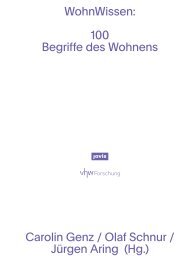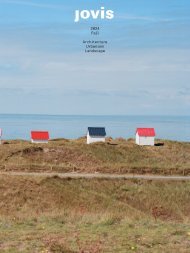Formful Wood. Explorative Furniture
ISBN 978-3-86859-588–8 https://www.jovis.de/de/buecher/product/formful-wood-explorative-furniture.html
ISBN 978-3-86859-588–8
https://www.jovis.de/de/buecher/product/formful-wood-explorative-furniture.html
You also want an ePaper? Increase the reach of your titles
YUMPU automatically turns print PDFs into web optimized ePapers that Google loves.
A TEACHING PROJECT TRANSCENDS DISCIPLINES<br />
This complex of topics forms the basis of our design workshop. In spring 2018, the<br />
Object Design department at Lucerne University of Applied Sciences and Arts<br />
and the Chair of Structural Design at ETH Zurich’s Department of Architecture<br />
launched a joint course that was taught to 28 students from both universities with<br />
the goal of designing and building seating objects made of plywood, as a collaborative<br />
effort. We received support from Artek, our industry partner, whose name<br />
combines the words art und technology, and who still employs the same, delicate<br />
handcrafted manufacturing processes that became the hallmark of their furniture.<br />
Artek’s so-called L-leg, a narrow curved chair leg, also dubbed the “little sister of<br />
the architectural column” by co-founder Alvar Aalto, is a typical example of these<br />
processes and became a launching pad for the design project. It is made using a<br />
combination of steam bending and molded plywood, whereby irregular cuts are<br />
sawn into the end of a piece of wood which was then bent and glued together<br />
with another piece using veneer strips. Three legs of this nature are subsequently<br />
mounted to the seat by the user himself. The uniqueness of this type of furniture<br />
turned it into a cult object. The intricate process could only be assembled through<br />
extensive testing in the workshop. Artek thus combines the curiosity and experimentation<br />
of design with craftsmanship and industrial practices. This philosophy<br />
makes Artek an ideal partner for our design workshop. Object design and architecture,<br />
craftsmanship and industry—crossing the boundaries of individual disciplines<br />
and schools of thought was a central goal pursued by the workshop and gave rise<br />
to a interdisciplinary research and work process among students and supervisors.<br />
The workshop started off with participants getting to know each other, as<br />
well as the industrial and craft work processes and materials. The head of Artek’s<br />
manufacturing operations in Turku, Finland, explained typical manufacturing methods<br />
via video conference. It was impressive how much these processes resembled<br />
time-honored manufacturing methods—a continuity that was also reflected<br />
in remarkably consistent products. This marked an important starting point for the<br />
students: processes were experimented with and used as springboards for new<br />
functions and forms. A visit to a veneer factory also made a significant impression<br />
on the students. There, they were able to observe how thin veneers were cut from<br />
a tree trunk and underwent further processing. Those two encounters, Artek’s<br />
L-leg and the flat veneers in the factory, opened wide the range of experimental<br />
approaches presented by the designs. Once the students had received a detailed<br />
introduction to manufacturing techniques and tools in the workshop, they settled<br />
down and began to work on their projects.<br />
11


















